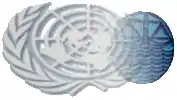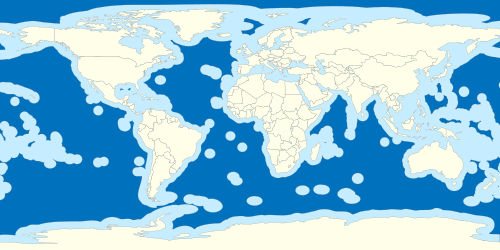Convention on the High Seas
The Convention on the High Seas is an international treaty which codifies the rules of international law relating to the high seas, otherwise known as international waters.[1] The convention was one of four treaties created at the United Nations Convention on the Law of the Sea (UNCLOS I).[2] The four treaties were signed on 29 April 1958 and entered into force on 30 September 1962, although in keeping with legal tradition, later accession was permitted.[3]
 | |
| Signed | 29 April 1958 |
|---|---|
| Location | Geneva, Switzerland |
| Effective | 30 September 1962 |
| Parties | 63 states (at 2013) |
| Languages | Chinese, English, French, Russian and Spanish |
| http://legal.un.org/ilc/texts/instruments/english/conventions/8_1_1958_high_seas.pdf | |
As of 2013, the treaty had been ratified by 63 states, including most NATO-bloc and Soviet-bloc nations but with the notable exceptions of most of the OPEC and Arab league nations like Syria, Egypt, Jordan, Saudi Arabia, and Iran, as well as China, North Korea, and South Korea.[4]
The convention on the High Seas was superseded by the 1982 UNCLOS III, which introduced several new concepts to the law of maritime boundaries including Exclusive Economic Zones.
Provisions

The treaty is divided into 37 articles:
Article 1: Definition of "high seas".
Article 2: Statement of principles
Article 3: Access to the sea for landlocked states
Articles 4–7: the concept of a Flag State
Article 8: Warships
Article 9: Other ships in government service
Articles 10–12: Safety, rescue
Article 13: Outlawing transport of slaves at sea
Articles 14–21: Piracy
Article 22: Boarding of merchant ships by warships
Article 23: Hot pursuit, that is, pursuit of a vessel across borders for the purposes of law enforcement
Articles 24–25: Pollution
Articles 26–29: Submarine cables and pipelines
Articles 30–37: legal framework, ratification, accession
References
- CONVENTION ON THE HIGH SEAS - Membership
- Text of CONVENTION ON THE HIGH SEAS (U.N.T.S. No. 6465, vol. 450, pp. 82-103)
- Convention on the High Seas, Done at Geneva on 29 April 1958
- United Nations Treaty Collection - Chapter XXI: Law of the Sea